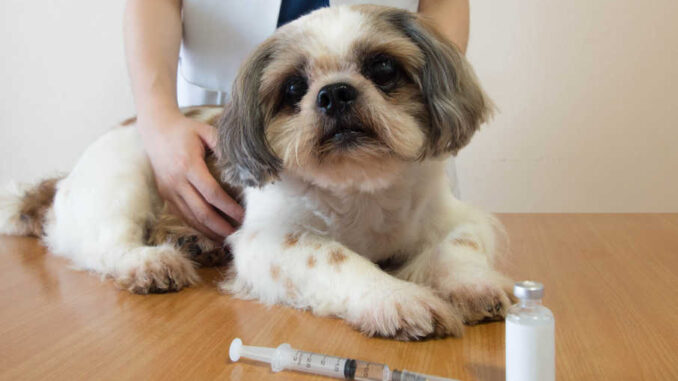
This article was updated on December 5th, 2022
Recently, a really sick cat was brought into my emergency clinic. She was overweight but was losing a significant amount of weight. The owners noted she was drinking and urinating more frequently than usual for the last week, and she’d even been walking funny. For the last 24 hours, she had not eaten, hadn’t had anything to drink, and was severely lethargic.
Diabetes was at the top of my differential list. The question was, was she in Diabetic Ketoacidosis (DKA) crisis?
While this recent scenario occurred with a cat, I have also seen similar cases with dogs. Canines and felines can both suffer from diabetes and ketoacidosis. So, how does diabetes affect dogs and their life expectancy?
What is my dog’s life expectancy with and without treatment for diabetes?
If your dog goes untreated, the average life expectancy following diagnosis is about 60 days. However, your pup can enjoy a a long, high quality life with treatment.
While it’s impossible to give an exact time frame for how long a dog will live with diabetes, the average life expectancy after diagnosis is around two years. However, this number will depend on:
- Your dog’s age at diagnosis
- The severity or stage of the disease at diagnosis
- Whether there was an early diagnosis
- Treatment with a suitable insulin dosage
- Your dog’s diet and lifestyle
If you’re willing to give your dog daily insulin injections and provide other lifelong treatment, your dog’s life expectancy is much longer than average. Many dogs live 3-8 or more years after receiving a diabetes diagnosis.
How can I make my dog’s life better with diabetes?
There are several things you can do to support your pooch and improve his quality of life if he has diabetes.
- Work closely with your veterinarian to develop a treatment plan
- Administer insulin as instructed
- Regularly monitor blood sugar levels
- Exercise your dog regularly
- Adjust your dog’s diet to achieve and maintain a healthy weight
Long-term Care
Consistency is key when managing a diabetic. This includes diet type, amount (including treats) and timing. Any change can offset the balance and potentially put the dog back in crisis. Insulin therapy is usually for life. It is imperative that the dose recommended by the veterinarian is followed accurately. Dose alternations should be conducted under a vet’s direction and need to be carefully monitored. At home monitoring can be accomplished with urine dipsticks or blood sugar sticks with a veterinary approved glucometer. However, dogs don’t need as strict regulation as humans. The goals of therapy are to control the clinical signs and avoid hypoglycemia.
It is important to know what to expect, as managing this disease can be frustrating, time-consuming, and expensive. However, when properly regulated, the pet can enjoy a good quality of life.
Can dogs survive diabetes without treatment?
There is no cure for diabetes. If dogs aren’t treated for diabetes, their body’s cells can’t access the energy they need to power organs and normal functioning. This triggers a cascade of events and results in damage to multiple vital organs and eventual death. Early diagnosis and treatment are crucial to increase the chance that your pooch will have a good prognosis and enjoy a high quality of life.
How will diabetes affect my dog?
Diabetes in dogs is a chronic metabolic disease that can be managed but not cured. In canines, there are three possible types of diabetes
- Type I diabetes in dogs is similar to the same type in humans. In this case, the pancreatic cells that secrete insulin are damaged, so the body can’t produce insulin for sugar metabolism. Dogs with Type I diabetes require insulin supplementation.
- Type II diabetes in dogs, as with humans, is a condition in which the body has trouble using insulin properly. It’s more common in older, obese dogs.
- Type III diabetes is often temporary and occurs in pregnant females. This type is rare in dogs, but when it occurs in a bitch, it’s likely to repeat with future pregnancies.
Each type of diabetes affects dogs in the same way. The cells aren’t able to effectively take up and use blood sugars. As a result, the concentration of sugars in the blood and urine increases.
At the same time, cells that aren’t getting the glucose they need, signal the liver to produce more glucose. The liver breaks down fat stores and muscle to manufacture more glucose. Unfortunately, this places a strain on the liver.
The cascade of events has several effects on dogs. In the early stages, owners may notice:
- Increased drinking
- Increased urination
- Increased appetite/eating
- Loss of muscle mass
- Weight loss
- Recurring bladder infections
If diabetes isn’t diagnosed and treated, the high concentration of sugar in the blood upsets normal chemistry. Over time, this can cause damage to the liver, kidneys, eyes, and other organs. The long-term effects of diabetes can include:
- Loss of appetite
- Lethargy and depression
- Vomiting
- Seizures
- Enlarged liver
- Kidney failure
- Cataracts
- Diabetic ketoacidosis (DKA)
What is DKA & What Does it Mean for a Dog’s Life Expectancy?
Diabetic ketoacidosis (DKA) is a critical state in which the blood becomes too acidic for normal cell functions to operate. This usually occurs due to prolonged, unregulated diabetes mellitus.
Diabetes mellitus is the abnormally high accumulation of sugar (glucose) in the bloodstream due to the body’s inability to bring it into the cells. This is usually insulin dependent in dogs, similar to Type I diabetes in people.
Insulin is a hormone that allows the transportation of sugar molecules from the blood into the cells. Normally, the pancreas produces insulin; in diabetics, the production is broken. The cause is often unknown, but experts speculate it could be due to genetic disturbances, pancreatic cell damage, chronic steroid exposure, or obesity.
However, even with plenty of sugar in the blood, the cells think they’re starving is there isn’t insulin to transport it. When this happens, the cells turn on their backup systems to get energy to maintain normal cell functions. That means they break down fat and proteins, which are less efficient than carbohydrates. One byproduct of protein breakdown is ketones.
Ketones by themselves are not harmful; the issue is when they build up in the bloodstream, it makes the blood acidic. Cell functions only operate within a specific pH range, so when the blood becomes too acidic, the normal pathways shut down, leading to a sick patient. This is known as Diabetic Ketoacidosis. Cats and dogs can sometimes compensate for a while with diabetes. It’s usually a second or concurrent illness that pushes them over the edge and leads to DKA.
What are the clinical signs of diabetes and DKA?

Clinical signs of diabetes in dogs include frequent drinking and urination, weight loss, and recurrent urinary tract infections. If the blood sugar gets high enough, the central nervous system can be affected, and seizures are possible. Another sign, more often seen in cats, is called a plantigrade stance, when they walk with their ankles on the ground. Additional clinical signs of a DKA patient may include dehydration, lethargy, decreased appetite, vomiting and diarrhea, heavy breathing, and shock.
Treatments for diabetes vs. DKA
Treatment for diabetes
Diabetes is not a curable disease, but it can usually be managed. While cats sometimes go into remission, this rarely occurs in dogs. Diabetic management includes insulin therapy (most often requires owners to give injections at home twice a day), special diets, consistent schedule and diet, and weight loss. It is important to be cautious with insulin, as too much could cause the blood sugar to drop too low (hypoglycemia).
When starting insulin therapy, it’s best for your vet to observe your dog throughout the day. He’ll regularly monitor your furbaby’s blood sugar to make sure it doesn’t drop too low. Before your pup is discharged, the clinic staff will teach you how to give your dog insulin injections. A week or two later, there will be a follow-up appointment to recheck blood sugar levels.
To help control diabetes and minimize harmful effects your veterinarian may also
- treat any underlying cause
- avoid medications that can lead to insulin resistance (steroids, cyclosporine, and progestins) when possible
- spay intact females (spikes in hormones may affect blood sugar levels)
Treatment for DKA
DKA patients are typically more critical and require hospitalization for at least a couple of days. This involves IV fluids for stabilization, correction of electrolyte and acid-base imbalances, and treatment of any secondary or underlying diseases. Once rehydrated, insulin therapy can be started to return the blood sugar back to normal. Care must be taken not to drop it too quickly, because a sudden and drastic drop in blood sugar can cause the brain to swell.
FAQs
Do All Diabetic Dogs Go Blind?
No, not all diabetics go blind. Diabetics are at a higher risk of developing cataracts. Swift recognition of the disease and proper management will lower the risk of this development. Additionally, there is a surgery pets can undergo to remove cataracts and regain vision.
How Long After Starting Insulin Will My Dog Feel Better?
Pets with DKA may be in the hospital for several days. The major components of their treatment include rehydration, electrolyte balancing, and gradually lowering their blood sugar levels. These pets usually start feeling a little better with some fluids alone (but are not ready to go home at that point). A lot of them eat again within a day or so once their acidosis is resolved and their blood sugar is closer to normal range.
Do Diabetic Dogs Sleep a Lot?
Sugars too high or too low can make them not feel well, and they can become lethargic. Well-regulated diabetics usually have normal activity, barring other issues (arthritis, obesity, etc.)
Why Do Diabetic Dogs Drink So Much Water?
Sugar is a molecule that draws more fluid through the kidneys, thus diluting the urine. This is a process called osmotic diuresis. They drink more because their body is telling them they need more water because they are getting dehydrated from the extra fluid loss through the urine.
What Human Food Can I Feed My Diabetic Dog?
Low calorie snacks like carrots are fine. Stay away from high-carbohydrate foods, as that can cause a sudden spike in blood sugar. Also stay away from high fatty foods, which can predispose them to pancreatitis, and that can set off the balance you worked so hard to achieve.
How Do I Know if a Dog with Diabetes is Suffering?
The common signs of poor quality of life an unregulated diabetic may show include severe weight loss, poor appetite, severe lethargy, and even seizures.
When Should You Put a Diabetic Dog Down?
This is a very personal decision. Diabetes and DKA can be managed medically, but it can be extremely expensive and time-consuming. If the pet is not responding to treatments, or they become cost prohibitive, that may be a sign that euthanasia can be a reasonable option. Not treating this disease can be more unfair to them than humane euthanasia. If you are considering this, please have a conversation with your primary veterinarian, and consider seeing an internal medicine specialist, to discuss all of your options before choosing euthanasia.
Disclaimer: This website's content is not a substitute for veterinary care. Always consult with your veterinarian for healthcare decisions. Read More.


Be the first to comment